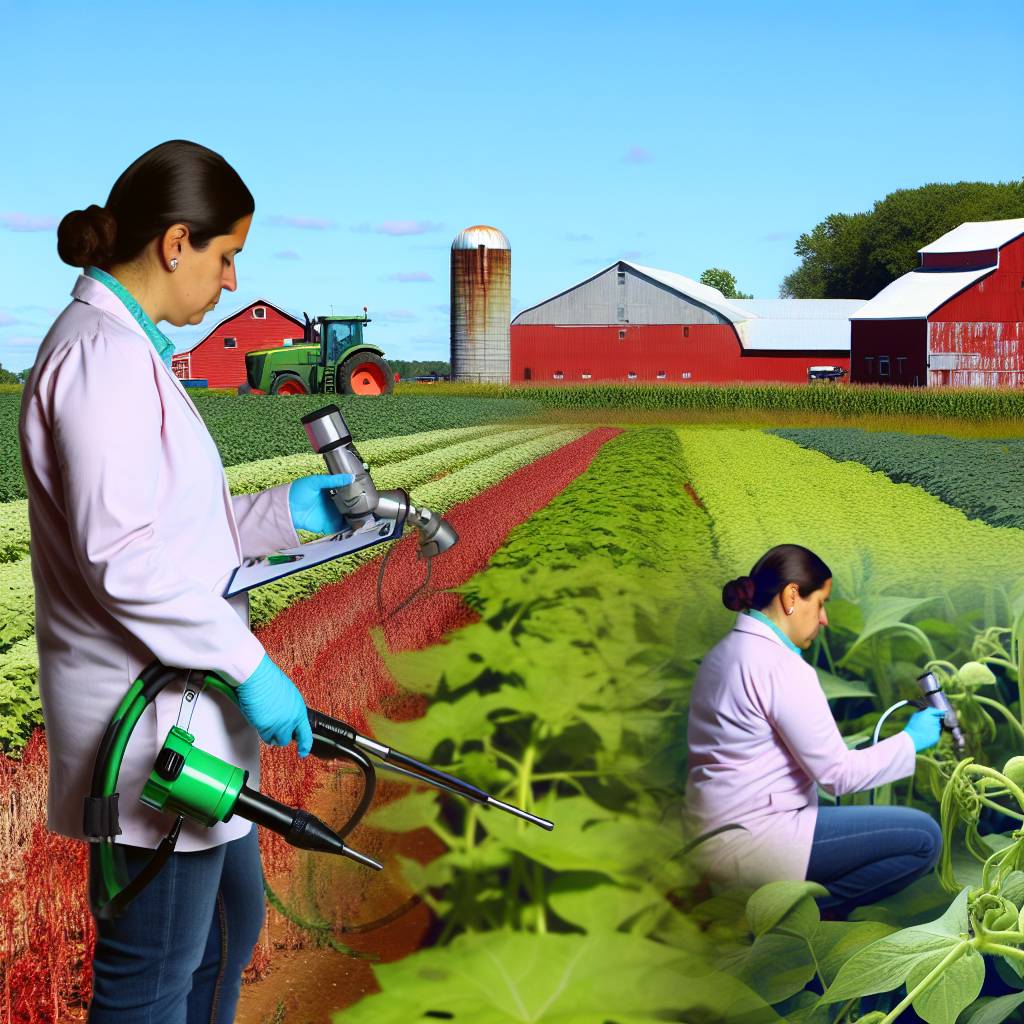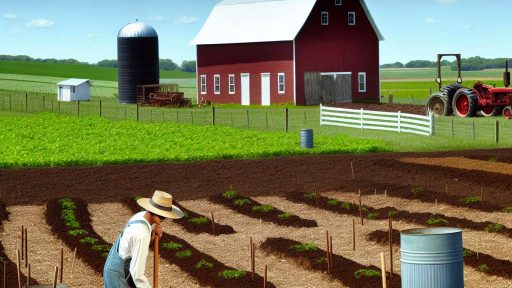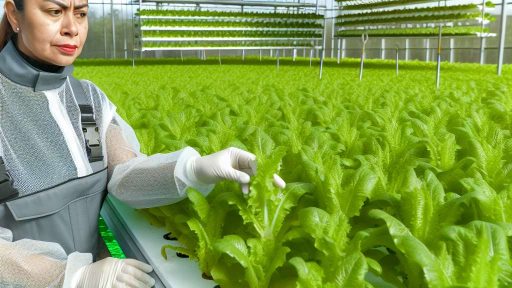Introduction to Crop Disease Management in Agriculture
Crop disease management plays a crucial role in maintaining agricultural productivity.
Farmers face numerous challenges from diseases that threaten crop yields.
Effective management strategies can mitigate these risks and preserve land value.
Understanding Crop Diseases
Crop diseases arise from various pathogens, including fungi, bacteria, and viruses.
Each pathogen can cause different symptoms and yield losses.
Identifying the specific disease is essential for effective management.
Importance of Early Detection
Early detection of diseases can prevent widespread crop loss.
Farmers should regularly inspect their fields for irregularities.
Using tools like digital imaging can enhance the detection process.
Integrated Disease Management Strategies
Integrated disease management combines various techniques for effectiveness.
These strategies include crop rotation, resistant varieties, and proper sanitation.
- Crop rotation disrupts disease cycles.
- Growing resistant varieties reduces disease incidence.
- Sanitation practices limit pathogen spread.
Utilizing Technology in Disease Management
Modern technology offers innovative solutions for managing crop diseases.
Farmers can employ precision agriculture tools to monitor crop health.
Drones and satellite imagery provide valuable data for informed decision-making.
Educating Farmers on Best Practices
Education is key in promoting effective disease management practices.
Transform Your Agribusiness
Unlock your farm's potential with expert advice tailored to your needs. Get actionable steps that drive real results.
Get StartedWorkshops and training programs can equip farmers with necessary skills.
Collaboration with agricultural extension services is vital for success.
Constructing a Community Response
A collective approach can enhance disease management efforts.
Farmers can share insights and experiences to tackle common challenges.
Community monitoring programs can facilitate early disease detection.
Overview of Common Crop Diseases and Their Impact on Land Value
Crop diseases affect agricultural productivity significantly.
Understanding different diseases helps farmers protect their land value.
Common crop diseases include blight, rust, and mildew.
These diseases can lead to reduced yields and economic losses.
Types of Common Crop Diseases
Blight is often caused by bacteria or fungi.
This disease can devastate crops rapidly.
Rust affects many grass species, including wheat.
Severe infestations can severely impact harvests.
Mildew thrives in humid conditions and affects various plants.
Economic Impact on Agriculture
Crop diseases lower yield and quality, impacting market prices.
Infected crops may lead to reduced profits for farmers.
This scenario diminishes the overall land value.
Land value reflects crop productivity and health.
Persistent diseases may deter future investment in agriculture.
Preventive Measures and Management Strategies
Implementing crop rotation can reduce disease prevalence.
Using resistant crop varieties is another effective strategy.
Regular monitoring helps in early detection of diseases.
Chemical treatments can mitigate the spread of diseases.
Farmers should educate themselves on best management practices.
Showcase Your Farming Business
Publish your professional farming services profile on our blog for a one-time fee of $200 and reach a dedicated audience of farmers and agribusiness owners.
Publish Your ProfileThe Role of Research and Technology
Research advances will improve disease management strategies.
Technology, such as apps, aids in monitoring crop health.
Genetic engineering can create disease-resistant varieties.
Collaboration with agricultural experts leads to better outcomes.
Investing in research ultimately protects land value.
Cultural Practices to Prevent Crop Diseases
Importance of Early Detection
Early detection of crop diseases is crucial for effective management.
Farmers should regularly inspect their fields for any signs of disease.
This proactive approach minimizes potential yield losses.
Crop Rotation
Implementing crop rotation helps disrupt disease cycles.
Different crops can reduce the buildup of pathogens in the soil.
Moreover, rotating crops enhances soil health and fertility.
Soil Management
Healthy soil contributes significantly to disease resistance.
Utilizing compost and organic matter improves soil structure.
Additionally, regular soil testing ensures nutrient balance.
Water Management
Proper irrigation practices can prevent crop diseases.
Avoiding overwatering reduces the risk of fungal infections.
Moreover, ensuring good drainage helps maintain optimal soil moisture.
Sanitation
Maintaining cleanliness in the field is vital for disease prevention.
Farmers must regularly clean their tools and equipment.
This practice helps avoid introducing pathogens into healthy crops.
Selecting Resistant Varieties
Choosing disease-resistant crop varieties is an effective strategy.
These varieties can withstand specific pathogens, reducing losses.
Additionally, they often require fewer chemical treatments.
Incorporating Companion Planting
Companion planting can enhance crop health and deter pests.
Certain plants can repel harmful insects or attract beneficial ones.
This approach promotes biodiversity in the agricultural ecosystem.
Regular Monitoring and Record Keeping
Regular monitoring of crops allows for timely interventions.
Farmers should keep detailed records of pest and disease occurrences.
This information is valuable for future decision-making.
Gain More Insights: Smart Irrigation Methods for Sustainable Crop Cultivation on Land
Chemical Control Methods
Overview of Chemical Control
Chemical control methods are essential for effective crop disease management.
Farmers utilize herbicides, fungicides, and insecticides to maintain healthy crops.
Each type targets specific pests or diseases, ensuring crop protection.
Herbicides
Herbicides help manage unwanted plants that compete with crops.
They can be pre-emergent or post-emergent, depending on application timing.
Pre-emergent herbicides prevent weed seeds from germinating.
Post-emergent herbicides eliminate weeds after they have sprouted.
Farmers must carefully select herbicides based on weed type and crop compatibility.
Types of Herbicides
There are two primary categories of herbicides: selective and non-selective.
Selective herbicides target specific weeds while leaving crops unharmed.
Showcase Your Farming Business
Publish your professional farming services profile on our blog for a one-time fee of $200 and reach a dedicated audience of farmers and agribusiness owners.
Publish Your ProfileNon-selective herbicides kill all plant material they contact.
Farmers should consider their desired results when choosing a herbicide type.
Fungicides
Fungicides combat fungal diseases that threaten crop yields.
They can be applied as preventive measures or to control existing infections.
Different fungicides target specific types of fungi.
Examples include those effective against rust, mildew, and blight.
Application Techniques for Fungicides
Proper application is crucial to the effectiveness of fungicides.
Farmers should follow label instructions for dosage and timing.
Common application methods include spraying and seed treatment.
These techniques ensure optimal coverage and absorption.
Insecticides
Insecticides protect crops from insect infestations that can cause severe damage.
They act directly on insect pests or disrupt their reproductive cycles.
Farmers have a variety of insecticides to choose from based on the target insect.
Integrated Pest Management with Insecticides
Integrated Pest Management (IPM) combines different pest control strategies.
This approach minimizes reliance on chemical controls, protecting the environment.
IPM may include biological controls alongside chemical insecticides.
Such methods contribute to sustainable agriculture by promoting biodiversity.
Safety and Environmental Considerations
Using chemical control methods requires strict adherence to safety protocols.
Farmers must protect themselves and the surrounding environment.
Proper protective equipment is essential during application processes.
Additionally, understanding the impact of chemicals on non-target species is crucial.
Farmers should strive to minimize chemical runoff into water sources.
Discover More: Essential Greenhouse Construction Tips For Emerging Farmland Investors
Biological Control Methods and Integrated Pest Management
Introduction to Biological Control
Biological control utilizes natural predators to manage crop pests.
This method reduces reliance on chemical pesticides.
For instance, ladybugs can effectively control aphid populations.
By promoting biodiversity, farmers can enhance natural ecosystem services.
Types of Biological Control Agents
Several types of biological control agents exist.
- Predators target and reduce pest populations.
- Parasitoids lay eggs in or on hosts, leading to their demise.
- Pathogens infect pests, causing population declines.
Farmers can introduce these agents or conserve existing populations.
In addition, establishing habitats for beneficial organisms is crucial.
Integrating Biological Control into IPM
Integrated Pest Management (IPM) combines multiple strategies for effective pest control.
Biological control fits seamlessly within this framework.
IPM emphasizes prevention and monitoring of pest populations.
Farmers assess the effectiveness of biological agents regularly.
Moreover, they can adjust their strategies based on results.
Benefits of IPM with Biological Control
IPM, combined with biological control, offers multiple benefits.
- Reduced chemical inputs lead to less environmental impact.
- Healthier soils result from enhanced biodiversity.
- Increased resilience against pest outbreaks ensures consistent yields.
Farmers who adopt these methods often see improved crop quality.
Additionally, they can maintain higher market values for their land.
Challenges in Implementing These Strategies
Despite the advantages, challenges persist in adopting biological control.
Farmers may encounter difficulties in identifying effective agents.
Showcase Your Farming Business
Publish your professional farming services profile on our blog for a one-time fee of $200 and reach a dedicated audience of farmers and agribusiness owners.
Publish Your ProfileFurthermore, establishing the right conditions for their success can be complex.
Education and training play a vital role in successful implementation.
Moreover, ongoing research helps refine these strategies.
Delve into the Subject: Harvesting Methods for Diversified Farmland Investments
Technology in Disease Detection
Advancements in Detection Tools
The agricultural sector experiences ongoing advancements in disease detection technology.
These innovations include remote sensing, drones, and specialized software.
Notably, remote sensing captures large-scale data over crops efficiently.
Drones provide a bird’s-eye view of fields, spot early disease symptoms, and monitor plant health.
Moreover, specialized software analyzes data to identify specific disease patterns.
Role of Artificial Intelligence
Artificial intelligence (AI) revolutionizes the way farmers approach disease management.
AI analyzes vast amounts of data for quick and accurate disease detection.
This technology also predicts potential outbreaks based on historical data.
Consequently, farmers can take proactive steps to mitigate risks effectively.
Mobile Applications
Mobile apps are becoming essential tools for farmers managing crop health.
These apps provide real-time information and disease identification features.
Farmers can quickly upload images of affected plants for analysis.
As a result, they receive immediate feedback on necessary actions.
Genetic and Molecular Techniques
Genetic and molecular techniques offer highly precise disease detection capabilities.
These methods identify pathogens at the molecular level quickly and accurately.
Additionally, they help scientists develop resistant crop varieties.
This enhancement benefits both yield and sustainability in agriculture.
Integration of IoT Technology
The Internet of Things (IoT) integrates with agricultural practices to enhance disease management.
IoT devices monitor environmental conditions that contribute to disease development.
Data collected helps farmers make informed decisions about crop treatments.
Thus, integrating IoT technology leads to a more responsive approach to crop management.
Implications of Advancements in Disease Detection
Technology dramatically improves disease detection in agriculture.
With these advancements, farmers can protect their crops more effectively.
Ultimately, this maintains the value of agricultural land and supports food security.
Gain More Insights: Long-Term Weed Prevention Techniques for Large Landowners

Economic Analysis of Investing in Disease Management Strategies
Importance of Disease Management
Effective disease management significantly enhances crop yield.
It reduces losses associated with crop diseases.
Moreover, managing diseases protects the overall health of agricultural ecosystems.
Cost-Benefit Considerations
Farmers must weigh the costs of disease management against potential losses.
Investing in preventive measures can save money in the long run.
Such investments often lead to higher quality produce, increasing market value.
Additionally, reducing pest outbreaks can lower treatment costs.
Long-Term Economic Impact
Long-term investments in disease management show substantial returns.
Increased reliability in crop production enhances land value.
Stable crop yields make agriculture more attractive to investors.
Furthermore, resilience against diseases contributes to market stability.
Showcase Your Farming Business
Publish your professional farming services profile on our blog for a one-time fee of $200 and reach a dedicated audience of farmers and agribusiness owners.
Publish Your ProfileExamples of Disease Management Investments
Farmers may invest in advanced seed varieties with disease resistance.
They can also adopt integrated pest management techniques.
Utilizing technology for monitoring disease risks becomes increasingly popular.
Additionally, investing in staff training on disease management can improve outcomes.
Return on Investment Analysis
A thorough ROI analysis can clarify the value of disease management investments.
This analysis should include direct and indirect costs.
Potential increases in yields and reductions in crop loss represent significant benefits.
Long-term tracking of these investments strengthens future decision-making.
Seeking Financial Assistance
Farmers may explore government grants and subsidies for disease management.
Private partnerships and cooperative funding models often provide support.
Institutional investors may also prioritize funding sustainable farming practices.
Involvement in local agricultural programs can unlock additional resources.
Putting It All Together
Managing crop diseases is essential for sustainable agricultural practices.
By strategically investing in these areas, farmers can boost their economic outcomes.
A strong focus on disease management not only protects crops but also enhances land value.
Case Studies: Successful Crop Disease Management Practices
Integrated Pest Management in Corn Farming
In central Illinois, farmers adopted integrated pest management (IPM) techniques.
This approach blends biological, cultural, and chemical methods for pest control.
Farmers monitored pest populations closely to apply targeted treatments.
As a result, crop yields improved while reducing pesticide use significantly.
Organic Disease Management in Tomato Production
A California farm utilized organic methods to manage tomato diseases.
They employed crop rotation to reduce soilborne pathogens.
Additionally, they applied compost teas to enhance soil health.
This practice led to healthier plants and reduced disease incidence.
Monitoring and Early Detection Systems
In Florida, a citrus grove implemented advanced monitoring systems.
They deployed sensors and drones to detect disease outbreaks early.
This technology enabled timely interventions that saved many trees.
Collaboration and Knowledge Sharing
A group of farmers in Texas formed a cooperative to share best practices.
They organized workshops on disease identification and management techniques.
Through collaboration, they achieved higher crop yields and sustainable practices.
Research and Innovation in Disease Resistance
Researchers in Oregon developed disease-resistant crop varieties for local farmers.
These new varieties showed significant resilience against common pathogens.
Farmers reported improved profits and reduced loss from crop diseases.
Future Trends in Crop Disease Management and Land Protection
Adoption of Innovative Technologies
Emerging technologies transform crop disease management practices.
Drones are increasingly used for monitoring crop health.
These tools provide real-time data on nutrient levels and disease outbreaks.
Moreover, precision agriculture employs sensors for targeted interventions.
This approach minimizes resource waste and maximizes effectiveness.
Integration of Biotechnology
Genetic engineering enhances the resilience of various crops to pathogens.
Additionally, CRISPR technology allows for precise modifications of plant genomes.
Showcase Your Farming Business
Publish your professional farming services profile on our blog for a one-time fee of $200 and reach a dedicated audience of farmers and agribusiness owners.
Publish Your ProfileThis innovation leads to shorter breeding cycles and faster results.
Farmers can swiftly adapt to disease threats and changing climates.
Collaboration Between Farmers and Researchers
Collaboration is vital for effective crop disease management.
Farmers share on-ground insights with researchers for tailored solutions.
This partnership facilitates the rapid dissemination of best practices.
Consequently, it empowers communities to manage diseases proactively.
Furthermore, educational programs keep farmers informed about new threats.
Focus on Sustainable Practices
Sustainable practices are gaining priority in agriculture.
Implementing crop rotation disrupts pathogen life cycles.
Cover crops enhance soil health and reduce disease pressure.
Organic methods foster biodiversity, which naturally helps manage pests.
Farmers increasingly adopt integrated pest management (IPM) strategies.
Utilization of Data Analytics
Data analytics offers valuable insights into disease prediction.
Farmers analyze historical data to anticipate future outbreaks.
Machine learning algorithms identify patterns in crop health trends.
Such analyses enable timely interventions to protect yields.
Ultimately, intelligent data usage minimizes economic losses.




